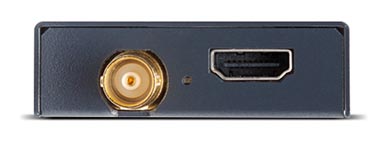The Thunderbolt protocol has ushered in a new era for easy connectivity of hardware peripherals. It allows users to deploy a single connection type to tie in networking, external storage, monitoring and broadcast audio and video input and output. Along with easy connections, it has also enabled peripheral devices to becomes smaller, lighter and more powerful. This is in part due to advances in the hardware and software, as well. AJA Video Systems is one of the popular video manufacturers that has taken advantage of these benefits.
In many modern editing environments, the actual editing system has become extremely streamlined. All it really takes is a Thunderbolt-enabled laptop, all-in-one (like an iMac) or desktop computer, fast external storage, and professional monitoring – and you are good to go. For many editors, live video output is strictly for monitoring, as deliverables are more often-than-not files and not tape. Professional monitoring is easy to achieve using SDI or HDMI connections. Any concern for analog is gone, unless you need to maintain analog audio monitoring. AJA makes a series of i/o products to address these various needs, ranging from full options down to simple monitoring devices. Blackmagic Design and AJA currently produce the lion’s share of these types of products, including PCIe cards for legacy installations and Thunderbolt devices for newer systems.
I recently tested the AJA T-Tap, which is a palm-sized video output device that connects to the computer using the Thunderbolt 2 protocol. It is bus-powered – meaning that no external power supply or “wall-wart” is needed to run it. I tested this on both a 2013 Mac Pro and a 2015 MacBook Pro. In each case, my main need was SDI and/or HDMI out of the unit to external monitors. Installation couldn’t be easier. Simply download the current control panel software and drivers from AJA’s website, install, and then connect the T-Tap. Hook up your monitors and you are ready. There’s very little else to do, except set your control panel configuration for the correct video/frame rate standard. Everything else is automatic in both Adobe Premiere Pro CC and Apple Final Cut Pro X. Although you’ll want to check your preference settings to make sure the device is detected and enabled.
One of the main reasons I wanted to test the T-Tap was as a direct comparison with the Blackmagic products on these same computers. For example, the current output device being used on the 2013 Mac Pro that I tested is a Blackmagic DesignUltraStudio Express. This contains a bit more processing and is comparable to AJA’s Io XT . I also tested the BMD MiniMonitor, which is a direct competitor to the T-Tap. The UltraStudio provides both input and output and offers an analog break-out cable harness, whereas the two smaller units are only output using SDI and HDMI. All three are bus-powered. In general, all performed well with Premiere Pro, except that the BMD MiniMonitor couldn’t provide output via HDMI. For unexplained reasons, that screen was blank. No such problem with either the T-Tap or the UltraStudio Express.
The real differences are with Final Cut Pro X on the Mac Pro. That computer has six Thunderbolt ports, which are shared across three buses – i.e. two connectors per bus. On the test machine, one bus feeds the two external displays, the second bus connects to external storage (not shared for maximum throughput), and the remaining bus connects to both the output device and a CalDigit dock. If the BMD UltraStudio Express is plugged into any connection shared with another peripheral, JKL high-speed playback and scrubbing in FCPX is useless. Not only does the video output stutter and freeze, but so does the image in the application’s viewer. So you end up wasting an available Thunderbolt port on the machine, if you want to use that device with FCPX. Therefore, using the UltraStudio with FCPX on this machine isn’t really functional, except for screening with a client. This means I end up disabling the device most of the time I use FCPX. In that respect, both the AJA T-Tap and the BMD MiniMonitor performed well. However, my subjective evaluation is that the T-Tap gave better performance in my critical JKL scrubbing test.
One difference that might not be a factor for most, is that the UltraStudio Express (which costs a bit more) has advanced processing. This yields a smooth image in pause when working with progressive and PsF media. When my sequence was stopped in either FCPX or Premiere, both the T-Tap and the UltraStudio yield a full-resolution, whole-frame image on the HDMI output. (HDMI didn’t appear to function on the MiniMonitor.) On the TV Logic broadcast display that was being fed vis SDI, the T-Tap and MiniMonitor only displayed a field in pause, so you get an image with “jaggies”. The UltraStudio Express generates a whole frame for a smooth image in pause. I didn’t test a unit like AJA’s Io XT, so I’m not sure if the more expensive AJA model offers similar processing. However, it should be noted that the Io XT is triple the cost of the UltraStudio Express.
The elephant in the room, of course, is Blackmagic Design DaVinci Resolve. That application is restricted to only work with Blackmagic’s own hardware devices. If you want to run Resolve – and you want professional monitoring out of it – then you can’t use any AJA product with it. However, these units are so inexpensive to begin with – compared with what they used to cost – it’s realistic to own both. In fact, some FCPX editors use a T-Tap while editing in FCPX and then switch over to a MiniMonitor or UltraStudio for Resolve work. The reason being the better performance between Final Cut and the AJA products.
Ultimately these are all wonderful devices. I like the robustness of AJA’s manufacturing and software tools. I’ve used their products over the years and never been disappointed with performance or service if needed. If you don’t need video output from Resolve, then the AJA T-Tap is a great choice for an inexpensive, simple, Thunderbolt video output solution. Laptop users who need to hook up to monitors while working at home or away will find it a great choice. Toss it into your laptop bag and you are ready to rock.
©2017 Oliver Peters











 Currently the T-Tap works with a variety of editing hosts, including Avid Media Composer/Symphony/NewsCutter (6.5/10.5), Apple Final Cut Pro 7/X and Adobe Premiere Pro CS6. AJA does not employ a unified installer, so the basic driver software package that you download enables the unit to work with Apple products. Use with Adobe or Avid systems requires the download of additional plug-ins. The package also includes a number of AJA utilities, such as software to output QuickTime media files through the T-Tap without launching any other NLE application. T-Tap does not work with Autodesk Smoke 2013, yet, nor does it work with DaVinci Resolve, since Blackmagic Design restricts output to their own products.
Currently the T-Tap works with a variety of editing hosts, including Avid Media Composer/Symphony/NewsCutter (6.5/10.5), Apple Final Cut Pro 7/X and Adobe Premiere Pro CS6. AJA does not employ a unified installer, so the basic driver software package that you download enables the unit to work with Apple products. Use with Adobe or Avid systems requires the download of additional plug-ins. The package also includes a number of AJA utilities, such as software to output QuickTime media files through the T-Tap without launching any other NLE application. T-Tap does not work with Autodesk Smoke 2013, yet, nor does it work with DaVinci Resolve, since Blackmagic Design restricts output to their own products. I found that some settings in the AJA Control Panel would sort of override the host NLE’s setting. This is especially true of FCP X. For example, I was playing a 23.98 timeline, but had the T-Tap set to 29.97i output. It did display as a 1080i signal, but with a 2:2:2:4 rather than the proper 2:3:2:3 pulldown cadence added. However, when I played the same media in FCP 7 using a 1080p/23.98 sequence, but with the playback set to 29.97i in the FCP menu, the output and display used the correct pulldown cadence. This has less to do with the capabilities of the T-Tap and more to do with what the host software allows or takes advantage of. Although there is no secondary format (upconverted or downconverted) output, as with the KONA cards, you can set the primary playback to be downconverted from within the NLE software. Testing the same 1080p/23.98 sequence in FCP 7, I was able to change the playback settings to 720p/59.94 (downsampled and cadence inserted) and the T-Tap performed beautifully, just like a standard PCIe card.
I found that some settings in the AJA Control Panel would sort of override the host NLE’s setting. This is especially true of FCP X. For example, I was playing a 23.98 timeline, but had the T-Tap set to 29.97i output. It did display as a 1080i signal, but with a 2:2:2:4 rather than the proper 2:3:2:3 pulldown cadence added. However, when I played the same media in FCP 7 using a 1080p/23.98 sequence, but with the playback set to 29.97i in the FCP menu, the output and display used the correct pulldown cadence. This has less to do with the capabilities of the T-Tap and more to do with what the host software allows or takes advantage of. Although there is no secondary format (upconverted or downconverted) output, as with the KONA cards, you can set the primary playback to be downconverted from within the NLE software. Testing the same 1080p/23.98 sequence in FCP 7, I was able to change the playback settings to 720p/59.94 (downsampled and cadence inserted) and the T-Tap performed beautifully, just like a standard PCIe card.